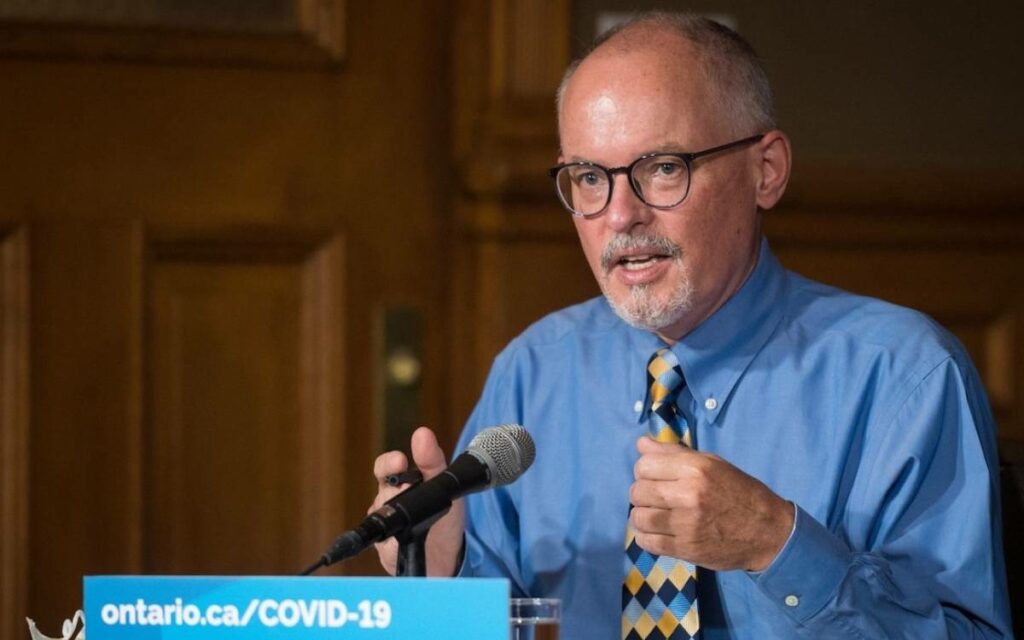
In a leaked letter from last week, Ontario’s chief medical officer of health Dr. Kieran Moore (pictured) told Niagara’s acting medical officer of health Dr. Mustafa Hirji that he was concerned Hirji’s excess “will lead to increased harms to the children and youth in the Niagara region”. Photo credit: The Canadian Press/Tijana Martin
Late Wednesday night, a letter sent from Ontario’s chief medical officer of health Dr. Kieran Moore to Niagara’s acting medical officer of health Dr. Mustafa Hirji leaked online.
The two-page rebuke from Jan. 15 scolded the head of Niagara’s public health department for making local school boards implement additional measures over and above provincial health and safety guidelines.
“I am writing to express my concern with your approach to in-person school and childcare in the Niagara region,” wrote the province’s top doctor.
According to Moore, while Hirji consulted with Niagara’s board of health and the region’s school boards, he did not run his strategy by the Office of the Chief Medical Officer of Health, Public Health Ontario, the Council of Medical Officers of Health, nor any of the pertinent provincial ministries.
Moore’s criticism focused on three aspects of Hirji’s plan: weekly classroom CO2 monitoring, dismissal of classroom cohorts, and required medical notes for masking exemptions.
Regarding the second measure, Hirji’s plan requires schools to maintain contact management and dismiss entire cohorts of students for seven days following a test-confirmed COVID-19 infection.
“You are aware that Niagara is the only jurisdiction in Ontario or Canada to continue this practice in the face of the increased transmissibility of the Omicron variant,” wrote Moore, “and that the negative consequences of school dismissal and closure are significant to the mental, physical, social and educational wellbeing of children and youth.”
Ontario’s chief medical officer of health additionally took issue with Hirji’s framing and assessment of the current situation and severity of the Omicron variant.
“[You] describe the severity of illness and high risk from the Omicron variant without providing any evidence to support this claim and contrary to the best evidence available of the risk on morbidity and mortality in the pediatric population,” Moore wrote in his letter.
“I am concerned that these measures will lead to increased harms to the children and youth in the Niagara region and strongly urge you to reconsider your approach in alignment with provincial direction.”
For his part, on Thursday Dr. Hirji thanked the province for reopening schools, as well as the additional feedback, but ultimately said he would not change his approach to in-person learning.
“Public Health is building on the solid foundation set by the province with some additional local measures that reflect our local context and the local patterns of spread we have seen in schools,” Hirji said in a statement to The Niagara Independent.
“We appreciate the feedback of the Chief Medical Officer of Health regarding these measures and have discussed them with our school board partners. We have adapted some of the details of how our recommended measures will be implemented in consideration of the easing workload on our school boards, but will be proceeding with these measures in order to give children, teachers, and other school staff additional protection as we successfully resume in-person schooling.”
In a follow up question, Hirji was asked what exactly Niagara Region Public Health (NRPH) has seen locally to convince him that Niagara is unique enough to necessitate additional measures. The Niagara Independent did not receive a reply by time of publication.
At a press conference later in the day on Thursday, Dr. Moore was asked by journalists about his letter to Hirji.
Moore said that the province wants “consistent and persistent messaging”, and that Hirji’s approach grates against advice provided by the Ontario COVID-19 Science Advisory Table.
“We have reviewed the science table’s recommendations, the importance of the mental, physical, social, and educational needs of our students and the desire to keep them in the classroom as much as possible,” said Moore. “And some of the recommendations that he [Hirji] had put in place could have increased the amount of absenteeism of students. It seemed to go contrary to the recommendations of the science table and our pediatric experts and our education experts.”
When asked by The Niagara Independent if the board supports the implementation of additional measures in schools, District School Board of Niagara (DSBN) spokeswoman Carolyn LoConte said that public health and the DSBN work in close collaboration to ensure students, staff, and the community are safe.
“NRPH has been an excellent partner to us long before COVID, and have been supporting DSBN families for many, many years,” said LoConte. “We rely on and greatly appreciate the medical expertise of Niagara Region Public Health and we take direction from the Ministry of Education for educating students and operating schools.”
It’s not certain how the letter from Dr. Moore initially leaked online. One of the first members of the public to post the document on social media Wednesday told The Niagara Independent that it was supplied to him anonymously.




















